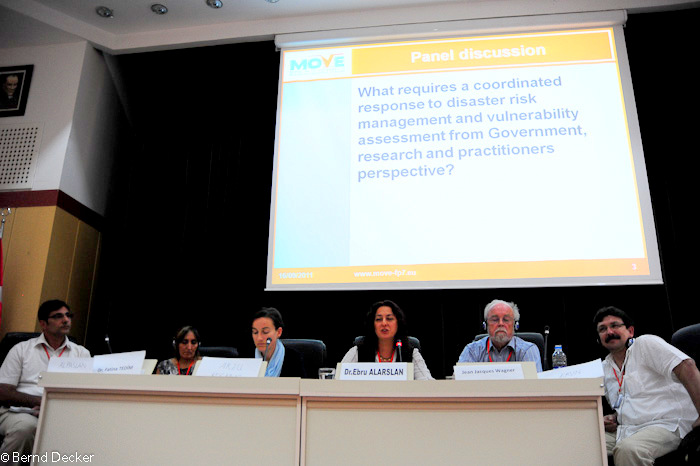MOVE PROJECT (MOVE METHODS FOR THE IMPROVEMENT OF VULNERABILITY ASSESSMENT IN EUROPE)
Both the heat wave in Europe in 2003 and Hurricane Katrina on the US Gulf coast in 2005 dramatically revealed that developed countries are far from immune from the worst effects of natural hazards. In addition to the increasing frequency and magnitude of extreme natural processes, growing urbanisation of hazardous areas, high levels of dependency on critical infrastructure and the increasing vulnerability of particular social groups, for example within an ageing population, point to an urgent need to improve our knowledge of vulnerability in Europe. Although it is widely acknowledged that the reduction and measurement of vulnerability are important tasks, the concept of vulnerability remains relatively unclear and under-researched, particularly in highly developed regions.
In this context we must recognize that there is a lack of a common ground between different disciplines and schools of thought regarding what vulnerability means as a scientific concept. There is a general understanding that it involves at least three things: susceptibility to harm, the extent to which people and goods are predisposed to impact, and conditions that favour damage. However, different disciplines apply the term in different ways. While the disaster risk community and economic risk analysts often view vulnerability as the potential for economic losses that a society, city or household might experience due to a hazardous event (e.g. Dilley et al. 2005), development theorists and social science researchers view the concept in terms of the underlying factors that increase the likelihood of people to be affected negatively or harmed by a hazardous event (e.g. Bohle 2001, Wisner 2004). In these studies, self-protection and coping strategies are often taken into account. Moreover, the climate change community has also developed its own understanding of vulnerability, which in some cases is defined as the ability of a system to resist extreme events and changes in climate. Thus, there is a conspicuous absence of a common framework for the definition and measurement of vulnerability with regard to its physical, social, economic, environmental, cultural and institutional nature.
MOVE will take into account the diversity of different approaches. It will review and compare them and then provide a generic framework for the definition of the transdisciplinary concept of vulnerability. Based on the identification of gaps in theory and current approaches, a common language will be developed in order to clarify exactly what vulnerability means. This will build a bridge between different disciplinary approaches and schools, rather than focussing solely on one discipline or upon any single feature of vulnerability. As indicated in the Hyogo Framework for Action (UN 2005), the principal challenge lies in the understanding and better framing of the multidimensional nature of vulnerability with regard to at least four spheres: physical (technical), social, economic and environmental. In order to learn the lessons of Hurricane Katrina, we have also added cultural and institutional dimensions to the concept we intend to develop.
MOVE will take into account past projects on vulnerability in Europe, such as RISK-EU, LESSLOSS, ARMONIA and RAMFLOOD and will analyse major gaps in knowledge that they have left. It will consider the applicability to Europe of vulnerability concepts and frameworks used in other regions of the world; for example, the vulnerability component of UNDPs Disaster Risk Index (UNDP 2004), the vulnerability indicators of the HOTSPOT project (Dilley et al. 2005), and the results of vulnerability measurement in the Indicator Program of the Americas (IDEA 2005). MOVE will identify which quality criteria are needed to improve the framework for vulnerability assessment for Europe.
The generic concept and framework will define the major characteristics and pillars of vulnerability. It will answer the question of whether vulnerability should be considered solely in terms of susceptibility and fragility, or whether it should also encompass ability to cope and adapt to changing environmental conditions and shocks, such as floods, landslides and earthquakes. It will also provide guidance on what physical, technical, social, economic, environmental, institutional and cultural vulnerability mean and how they can be assessed. Due to the stochastic aspects of the natural, built and social environments, uncertainties are an intrinsic part of any attempt to estimate vulnerability and are also present in the methods and models used to qualify or quantify it. As a result, uncertainties will explicitly be evaluated, reported and discussed with stakeholders and end-users. This will provide different stakeholders with a measure of the confidence level of estimates.
In order to improve the framework of analysis it is essential to create an integrated, comprehensive approach based on a multiple hazard, multi-dimensional, holistic view of risk and vulnerability. The generic framework developed by MOVE will refine existing methodologies in ways that capture the various dimensions and aspects of vulnerability. The generic approach will form the basis of a second step, in which different methodologies will be used to identify and measure particular features of vulnerability in a holistic and more comprehensive way than the current concepts, which often consider only one characteristic at a time.
Vulnerability reflects susceptibility, the intrinsic predisposition to harm, or in other words the conditions that facilitate damage. It is vitally important to understand how vulnerability is distributed and generated, and how it builds up. Carefully selected processes of identification, measurement and assessment will ensure that stakeholders, such as people who are responsible for the prevention and management of risk (disaster managers, urban planners and others) are made aware of it and are provided with adequate frameworks and instruments to assess and measure it. Thus the products of MOVE will help stakeholders understand the problem of vulnerability and will provide a means of guiding the decision-making process at different levels of public administration.
The development of new methods and tools to measure vulnerability can be seen as pillars of the generic framework which allow us to deepen the understanding of how vulnerability can be captured in different dimensions (see Figure 1). According to our hypothesis, disaster vulnerability correlates with physical susceptibility (including the built environment), environmental fragility, social-cultural issues and socio-economic contexts. In addition, vulnerability is heavily influenced by the lack of capacity to cope, recover and adapt in the face of disaster risks.

Under the generic framework of MOVE partners will develop distinct methodologies that will capture the different dimensions of vulnerability. In particular:-
Physical: for example, the degree of exposure of human settlements to a hazard and the likelihood of being affected by dangerous phenomena due to the location and physical conditions of buildings that will sustain certain hazard impacts.
Social: the conditions and predisposition of different social groups to suffer harm and damage due to a hazardous event, in relation to the demographic, ethnic, cultural or physical composition of the groups (e.g. elderly people or disadvantaged minorities) and to the levels of marginality and social segregation or other weaknesses and restrictions in the access to social, economic or health-related assets.
Economic: This dimension encompasses the potential monetary damage that a society or community might experience as the result of a hazardous event, and the different vulnerabilities and likelihoods that economic activities will be harmed or disrupted due to a specific hazard.
Environmental: On the one hand this involves the fragility of ecosystems under the duress of hazardous events and on the other the dependency of societies and specific economic activities on environmental services.
Cultural: This factor is related to natural and urban landscapes in terms of both their exposure to major natural hazards and their changing values and significance for individuals and communities.
Institutional: This aspect can be defined as lack of ability to involve all relevant stakeholders and effectively co-ordinate them right from the beginning of the decision-making process and according to risk communication processes. Mitigation, preparedness, response, recovery and adaptation activities are affected by institutional weaknesses and shortcomings.
Governance: This involves the development of good policies, administrative structures and consultative methods designed to manage and reduce vulnerability.
Overall, these dimensions provide the initial basis for a holistic and integrative perspective on vulnerability to natural hazards in European cities and regions. Some aspects have to be addressed with specific methods and modelling approaches. Physical and economic vulnerabilities must be addressed using probabilistic and deterministic approaches associated with damage scenarios and potential economic impacts: social and cultural vulnerability will be assessed with reference to demographic, institutional and cultural aspects defined by indicators, population data, statistics and qualitative judgements, which will be based also on new data generated through interviews and surveys.

Case study sites will be selected by considering different dimensions of vulnerability in relation to types of hazard and specific landforms, as shown in Figure 2. The different case studies will allow for bilateral comparisons to be made, for example in urban vulnerability assessment between London, Barcelona and Cologne. However, not all the methods will be tested in all case studies, but rather a selected group of those that are most appropriate to the areas under study, and to the general framework of the project. Guidelines will be defined in order to ensure that procedures and analyses are properly comparative. The different methods are described more precisely in the context of the case studies presented later in this document.
Testing the applicability of methodologies and refining them in case studies are crucial means of discovering which data can be gathered. Furthermore, applicability tests are an important element of the ability to examine under real conditions how one can combine data such as tools for economic assessment and those for social vulnerability estimation, such as the livelihood approach. In addition, the case-study applications will allow political decision-makers and stakeholders to be integrated into the development of standards for a better vulnerability assessment framework that will improve decision making in Europe.
The conceptual approach of the project is hierarchical (see Figure 1). This will facilitate the integration of different methods of measuring vulnerability and thus will create important links between different methods. In order to ensure that any methods that are developed can be applied, existing data will be taken into account in the methodological framework for vulnerability assessment in Europe. MOVE will conduct a reality check and will emphasise testing of the applicability of different methods.
As noted above, the research concept is based on a generic framework and the employment of different methodologies for the different dimensions of vulnerability. In order to ensure synthesis, rather than fragmentation and isolation, all methodologies will produce key indicators, indices and criteria that can be used to assess different aspects of vulnerability. Aspects and dimensions will be combined in a way that will develop composite indices for specific thematic areas or scales so as to integrate markedly different aspects of the problem. Use will be made of mathematical techniques for the treatment of uncertainty, subjective knowledge and incomplete information, such as fuzzy logic and sets, data mining, probability boxes, theory of evidence, and Monte Carlo simulations. These will support results and emerging indicators in reliable and robust ways. Additionally, different stakeholders and expert judges will be involved, for example through Delphi methods in order to define weighting factors and priorities for vulnerability indicators and assessment criteria. Sub-indices and criteria lists will be generated that will allow specific vulnerabilities to be identified within a single dimension that might be of special interest to a specific end user such as a disaster manager, urban planner, regional planner or EU policy-maker.
The basic research concept will be restricted to the development of a framework designed to improve methods for the assessment of vulnerability to natural hazards. This implies that different hazards are taken into account as well as different landforms, such as floodplains, mountain regions and coastal areas. The scales examined will vary from sub-national to local. For management strategies and the integration of vulnerability reduction into policies, the sub-national and local levels are the most appropriate scales of investigation. They also relate to the NUTS-1 to NUTS-3 levels at which important clusters of EU policy are developed. In addition, some vulnerability dimensions will be assessed at a finer spatial resolution. However, much effort will be devoted to exploring the important issue of the development of appropriate vulnerability units for up- and down-scaling (see Figure 3). MOVE will address the issue by analysing the scales at which the different features of vulnerability can best be measured and at which new vulnerability units can best be developed.


